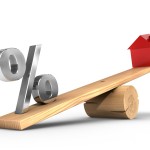 An interest rate rise of just 0.5% would cost households an extra £3.4 billion in interest payments in just the first year, accountancy firm Moore Stephens has warned.
An interest rate rise of just 0.5% would cost households an extra £3.4 billion in interest payments in just the first year, accountancy firm Moore Stephens has warned.
Bank of England data shows UK households are currently paying £39.2 billion in interest payments on debt that could be affected immediately by an interest rate rise.
If interest rates rose to just 0.75% from their current all-time low of 0.25%, that figure would jump to £42.6 billion. If interest rates hit 1%, household interest payments would leap to £46 billion.
The majority of that rise is driven by variable rate mortgages. UK borrowers currently have £591 billion of variable rate mortgages secured against their homes, at an average interest rate of 4.23%.
But record-high levels of consumer credit would also see households immediately paying an extra £440 million in interest on their credit card debt, overdrafts, car loans and unsecured personal loans.
The Bank of England is coming increasingly close to raising the base rate, with the Bank’s Monetary Policy Committee narrowly voting 5-3 to leave interest rates at 0.25% last month.
MPC member, Michael Saunders, recently warned people to prepare for higher interest rates following more than seven years of interest rates at or below 0.5%.
With inflation having hit 2.9% in May 2017, pressure is rising on the Bank of England to increase interest rates and bring inflation closer to its 2% target.
Michael Finch, partner at Moore Stephens, said: “Seven years of near-zero interest rates, rising house prices and ballooning consumer credit have created a ticking time bomb of debt – a rise in the base rate might trigger it.
“There is a growing need to raise interest rates to keep inflation under control, but households need to be aware of what that would mean for their debt repayments.
“Rates being so low for so long have created an entire generation of people for whom a bank rate above 1% is unheard of. There are a huge number of families with floating-rate mortgages who may get a very rude awakening on affordability once rates start to return towards what has historically been their normal level.
“There is a very real risk that a lot of people who have stretched themselves to afford a home will find themselves unable to keep up repayments when their 4% mortgage rate becomes 5%, 6% or 7%.
“That will get even worse as more and more fixed rate mortgages come to an end, and homeowners are forced to come to terms with higher interest rates.”
[box style=”4″]
What Mortgage has teamed up with London & Country to offer you expert advice on the right mortgage deal.
Whether you’re buying a new home, remortgaging to a new deal or buying an investment property, L&C can help – and you’ll pay no fee for their advice. To find out more, click here.
[/box]




